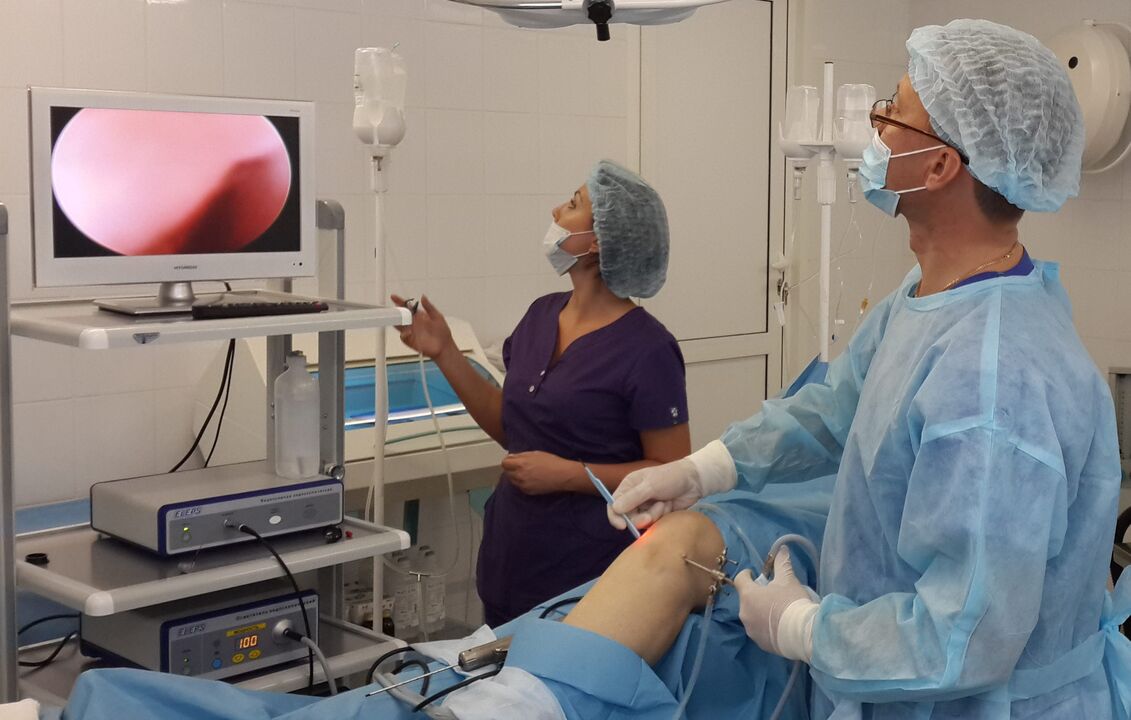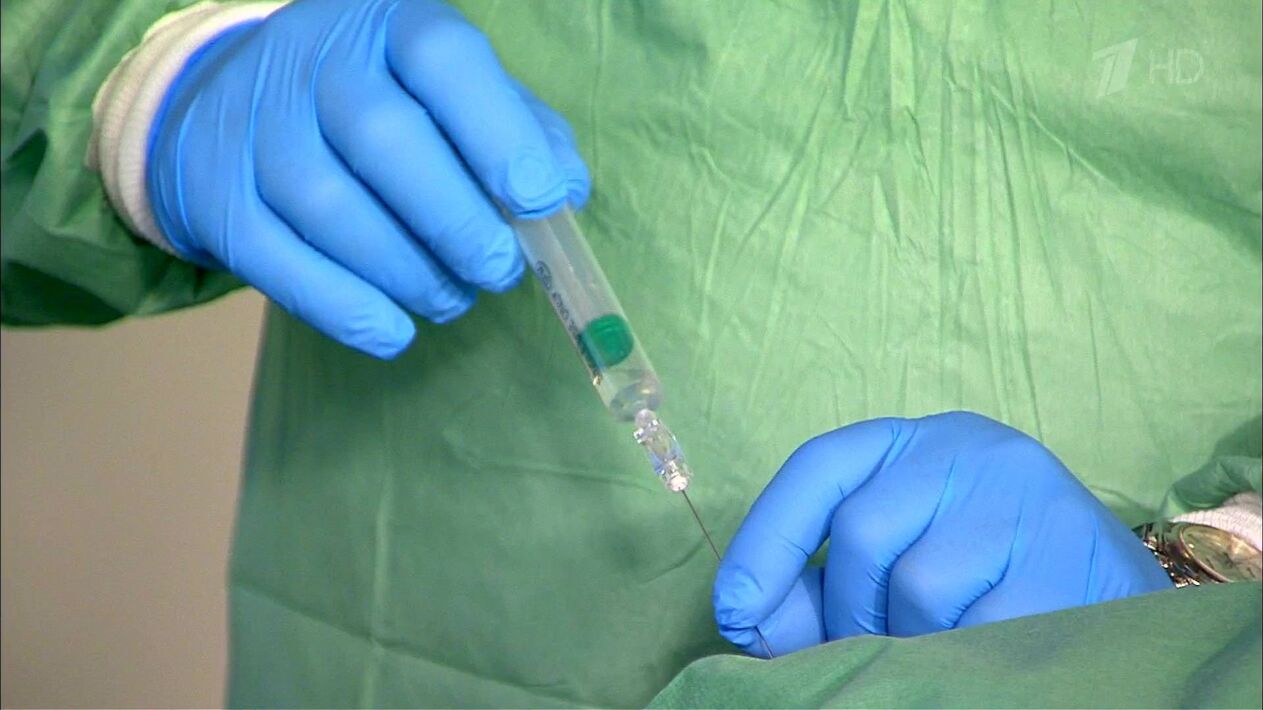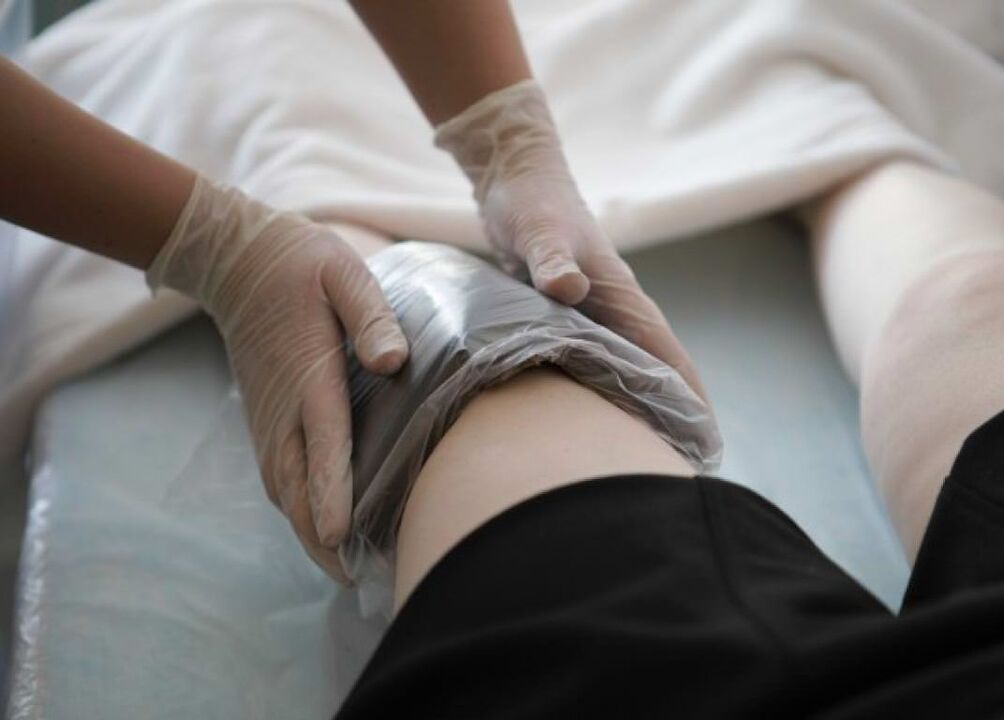Treatment of the knee joint is not a quick process, and it is not always possible to immediately get rid of pain. Most often they arise due to the destruction and deformation of cartilage tissue, but there may be other reasons. It is impossible to delay treatment, since joint diseases develop rapidly and can lead to serious consequences and even disability.
Causes of knee pain

The knee is an organ in which the patella is aligned with two bones. The cup, located in front of the knee, is connected by the tendons of the quadriceps muscle, which are extended by ligaments. The bones are covered with cartilage, and between them there is lunate cartilage - menisci. Additionally, the knee has several synovial sacs for fluid, which acts as a lubricant for the knee.
This whole complex mechanism is designed for flexion, extension and shock absorption during movement. Any violation in his work leads to discomfort and pain. How to treat knees should be determined by a traumatologist after diagnosis.
The causes of pain can be very diverse, from fatigue and overwork to serious illnesses, and they are distributed in this way:
- Knee injuries - all mechanical damage can be attributed to such reasons. Bruises, ruptures of ligaments, blood flow into the joint cavity with intra-articular fractures, injuries and ruptures of the menisci, dislocation of the patella. These causes are usually characterized by localized sharp pain, severe swelling, bruising, and difficulty or inability to move the joint.
- Inflammatory and degenerative joint diseases are the most common cause of knee pain in increasingly older people. Arthritis, osteoarthritis, chondropathy, bursitis, Schlatter's disease and other diseases. Characterized by increased pain or simply discomfort during movement, clicking sounds when flexing/extending the knee, pathological joint flexibility and chronic instability of the knee.
- Various systemic infectious and viral diseases also lead to inflammation and pain. These include osteoporosis, bone tuberculosis, syphilis, osteomyelitis and many others. Such pain can be of a different nature, depending on the inflammation of the body damaged by viruses and infections.
- Diseases in which the pain radiates to the knees. Sciatic nerve injury, osteoarthritis of the hip joints, fibromyalgia. Such pains are a side effect, so they are periodic pains or tightness. Treatment of the knee joint in such cases will not bring relief.
Diagnosis and finding the cause of the pain will determine how to treat the knee joint. When symptoms of unknown origin appear, it is better not to self-medicate.
knee treatment
Treatment for knee pain can be conservative or surgical. Surgical methods are an operation aimed at eliminating the cause of pain. Conservative therapy is a set of techniques aimed at eliminating symptoms and pathologies. So what is the treatment for knee pain?
Surgical methods
Such methods can be prescribed for serious injuries and inflammatory and degenerative diseases. Acute pain in the joints may indicate serious injuries or complete wear of the cartilage. Therefore, several types of operations are used.
Arthroscopy
Such an operation can be performed both for the purpose of diagnosing and treating severe joint damage. Arthroscopes are inserted into the knee through micro-incisions, one is equipped with a camera and displays an "image" on the screen, the other is intended for manipulations inside the joint, mainlyfor the treatment.
Such an operation significantly reduces the postoperative and rehabilitation period, moreover, it practically does not leave scars. Using an arthroscope, torn ligaments and menisci are operated on. Sometimes it is used to treat osteoarthritis, but its effectiveness in this case is still questionable.

Osteotomy
The most radical methodWith such an operation, the knee joint is completely opened, the patella is removed with the help of incisions, which allows manipulations directly into the cavity. This method is also called open. Usually, braces are applied to the bones, which greatly help to reduce the load on the joints.
A big minus of such an operation is a long period of rehabilitation. The patient will be able to walk after 1-2 months and lead an active life only after a year. But such surgery usually guarantees a long remission.
It should be known that the osteotomy is used in the event of lesion or severe deformation of the connective tissue, when a partial ablation of the diseased element is necessary.
Stents
It is performed when all other treatment methods have been exhausted, and the joint continues to collapse and completely ceases to perform its functions. After complete removal of the affected element by osteotomy, an implant is placed in the knee. It can be transplanted from a donor or replaced with an artificial prosthesis. They are made of plastic, ceramic or metal alloys.
In this way, the disease disappears completely and the patient achieves permanent remission. Nevertheless, it should be noted that the prosthesis can be rejected and other side effects are also possible. Israel remains the leader in joint replacement surgery.

For reference! In most cases, knee pain is treated in a more gentle way. And such therapy is very effective, and most importantly, it allows you to maintain an active lifestyle during the rehabilitation period.
Conservative treatments
These methods are a set of techniques aimed at the regeneration, healing and rehabilitation of the joints. It includes drug treatment, physiotherapy and gymnastic exercises, physiotherapy. In some cases, this may include folk methods. At the first manifestations of knee pain, it is worth choosing a knee brace or splint that will slow down the destruction of tissues before the start of the main treatment and reduce the symptoms of the disease.
Medical treatment
What is the first thing to do with knee pain? Of course, use painkillers and painkillers. These funds can be in different pharmacological forms. Ointments, tablets are recommended for dull, aching pains. For acute and tightness, it is better to resort to injections which will relieve the pain instantly.
Once diagnosed, nonsteroidal medications may be prescribed. With injuries, severe arthrosis and other degenerative diseases, the knee often swells. That's what these drugs are for. They improve blood circulation, reduce inflammation and relieve pain.

The last stage of drug treatment will be taking chondroprotectors. They are prescribed for absolutely any damage and change in the cartilage tissue. This is the basis of conservative treatment.
Do! Chondroprotectors, like bricks, restore cartilage. They have properties to regenerate them and restore their elasticity.
But it is worth preparing for the fact that treatment with chondroprotectors will be very long. The course lasts from three months to a year. The pharmacological form can be in the form of tablets, ointments and injections. By the way, such substances can also be found in food, so for pain in the knees, doctors recommend eating jelly, meat broths, avocados and jelly.
In some cases, intramuscular injections of hyaluronic acid may be prescribed. It is this substance that is part of the synovial fluid that fills the joint cavity. This will help in the regeneration of connective tissue and recovery will be much faster.
Exercise therapy and gymnastics
This is the most important stage both after surgical treatment and after drug therapy. Physiotherapy should also be done to prevent pain. It should take place under the supervision of a rehabilitation specialist in a special center or sanatorium for the correct implementation of a set of exercises. It usually takes 2-3 months.
With its help, the knee joint gradually resumes its active life, increasing the range of motion. Swimming will be the most important element. This will not only allow the joint to move smoothly, but also improve blood circulation and metabolism, which has a positive effect on tissue repair.
Physiotherapy
These procedures are aimed at safe recovery and treatment. These methods achieve the best result with the least amount of overhead. These include the following methods:
- ultrasound therapy;
- electrophoresis;
- infrared ray therapy;
- various warm-ups.
Otherwise, how can you treat your legs if your knee hurts badly? A good physiotherapy procedure is also massage, which increases blood circulation and speeds up the recovery process. Massage relieves pain well, and also has a general strengthening effect.
Topical preparations can be used without a doctor's prescription, such treatment is acceptable when the knees hurt. But most likely, this will only remove the symptoms, and the cause will remain, and sooner or later it will cause discomfort again.
Folk methods of treatment
How to treat knee pain with folk methods, probably every patient who has ever encountered this disease knows:
- The first way will be to warm the joint. It can be done at home using special vodka and honey compresses.
- You can visit a bath or sauna, which has a beneficial effect on the whole body as a whole.
- A very modern method of warming up will be a battery-heated brace. It is practical, comfortable and does not require much effort. One session can relieve pain in just 20-30 minutes.
- Mud and seaweed wraps also have a good effect on the joints. They are able to restore cartilage elasticity in a short time, improve blood circulation, which contributes to better tissue nutrition.
It is important to remember that with severe injuries and in the later stages of the disease, alternative methods will be ineffective. Therefore, any home treatment should be discussed with your doctor.

Patient feedback on treatment methods
It is impossible to answer the question of how to treat the knee joint without determining the cause, because as soon as symptomatic treatment in this case can turn the disease at an early stage into a chronic one. An integrated approach is still needed, and patient feedback confirms this.
- Woman, 55: "I have had knee pain for a long time. I did not understand the reason, then I went to the doctor anyway, and it turned out that I had osteoarthritis. Theyprescribed me chondroprotectors, which allowed me to forget about the pain with the help of exercise therapy. "
- Male, 35: "He suffered a serious knee injury - a ruptured meniscus. The attending physician prescribed an arthroscopy, after a short rehabilitation he returned to major sport. "
- Male, 48: "Unfortunately, osteoarthritis completely destroyed my joint, I did not pay attention to the painful pains for a long time. I had stents and a ceramic joint. I returned to an active life and Ieven started running in the morning. "
- Guy, 20: "I had a pinched sciatic nerve, it hurt my knee. I didn't understand the reason and smeared the joint with non-steroidal ointments. Then I went to the doctor and Idiscovered that these pains were secondary, and my knees are healthy. "





































